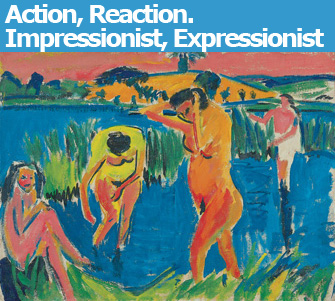 |
|
“Four Bathers” (1910) by Ernst Ludwig Kirchner. © Von der Heydt-Museum Wuppertal |
The Musée Marmottan Monet may be a temple dedicated to the great god of Impressionism, Claude Monet, but for a short time it is showing a group of paintings that illustrate some of the directions taken by European painters …
 |
|
“Four Bathers” (1910) by Ernst Ludwig Kirchner. © Von der Heydt-Museum Wuppertal |
The Musée Marmottan Monet may be a temple dedicated to the great god of Impressionism, Claude Monet, but for a short time it is showing a group of paintings that illustrate some of the directions taken by European painters reacting to Impressionism.
“Fauves and Expressionists: From Van Dongen to Otto Dix” (through February 20), with 50 works from the collection of the Von der Heydt Museum in Wuppertal, Germany, rather loftily purports to trace the development of Modernism in painting, beginning with the explosion of color initiated by the Fauves in France at the turn of the 20th century, continuing with the German Blaue Reiter (Blue Rider) movement and – more violently and less prettily – the Expressionists, and ending with the Dadaism-influenced New Objectivity movement, which was itself a reaction to the preceding movements.
With so few paintings and so many artists, however, the show can necessarily offer only a small sampling of works representing each movement. Its main attraction is the opportunity it offers to see a number of masterpieces by great artists, among them Raoul Dufy, Georges Braque, Maurice de Vlaminck, Kees Van Dongen, Ernst Ludwig Kirchner, Wassily Kandinsky, Alexej von Jawlensky, Franz Marc, August Macke, Gabriele Münter, Edvard Munch, Emil Nolde, Max Beckmann, Otto Dix and George Grosz. A few of the artists, such as Adolf Erbslöh, have less-familiar names but were well-worth discovering.
Among the show’s standouts are Van Dongen’s “Nu de Jeune Fille” (1906), with its astute and dramatic use of color: red highlights on the girl’s flowing blue hair and green modulations on her body. Nolde’s “Le Pont” (1910) is stunning in a way that only Nolde can be, with a kind of light-filled impressionistic Expressionism (the other painting by him here, “Nature Morte B,” 1914, is a mess by comparison). Of the several Kirchners, the best is “Four Bathers” (1910), with its vibrant colors. Jawlensky is represented by two strong portraits, one of which positively pops off the wall: it depicts a woman wearing a red and blue hat posed against a blue-green background holding red poppies against her red jacket and pink shirt.
The New Objectivity painters, eschewing the color theatrics of their predecessors, dulled their palette considerably. One of my favorite paintings in the show is Otto Dix’s “A la Beauté” (1922). You can almost taste the cynicism in this mysterious cabaret scene in muted colors in which the figures – dominated by a gangsterish man with a threateningly thrusting jaw – are reduced to automatons. To the right of the menacing central figure is a bust of a tarty-looking blond who could be his moll. In the background a couple and a woman in a corset dance to the music provided by a black drummer with an Indian chief painted on his bass drum, while waiters emerge from the shadows.
This show also offers a great excuse to revisit this marvelous museum in a mansion, all spiffed up and lovelier than ever, with its large collection of paintings by Monet and other Impressionists. The Marmottan is the home of Monet’s famed “Impression, Sunrise,” which gave the movement its name. On the day I was there, there wasn’t a guard (or even another visitor) in sight in the room where this surprisingly small picture hangs with several other works by Monet, even though the iconic painting has already been stolen and recovered once; let’s hope that the museum has installed a sophisticated invisible security system.
Musée Marmottan Monet: 2, rue Louis-Boilly, 75016, Paris. Métro: Muette. Tel.: 01 42 24 07 02. Open Tuesday, 11am-9pm, Wednesday-Saturday, 11am-6pm. Closed Monday, Christmas Day and New Year’s Day. Admission: €9. Through February 20. www.marmottan.com
Buy related books and films from the Paris Update store.
More reviews of Paris art shows.
Reader Reaction
Click here to respond to this article (your response may be published on this page and is subject to editing).
© 2009 Paris Update
Favorite